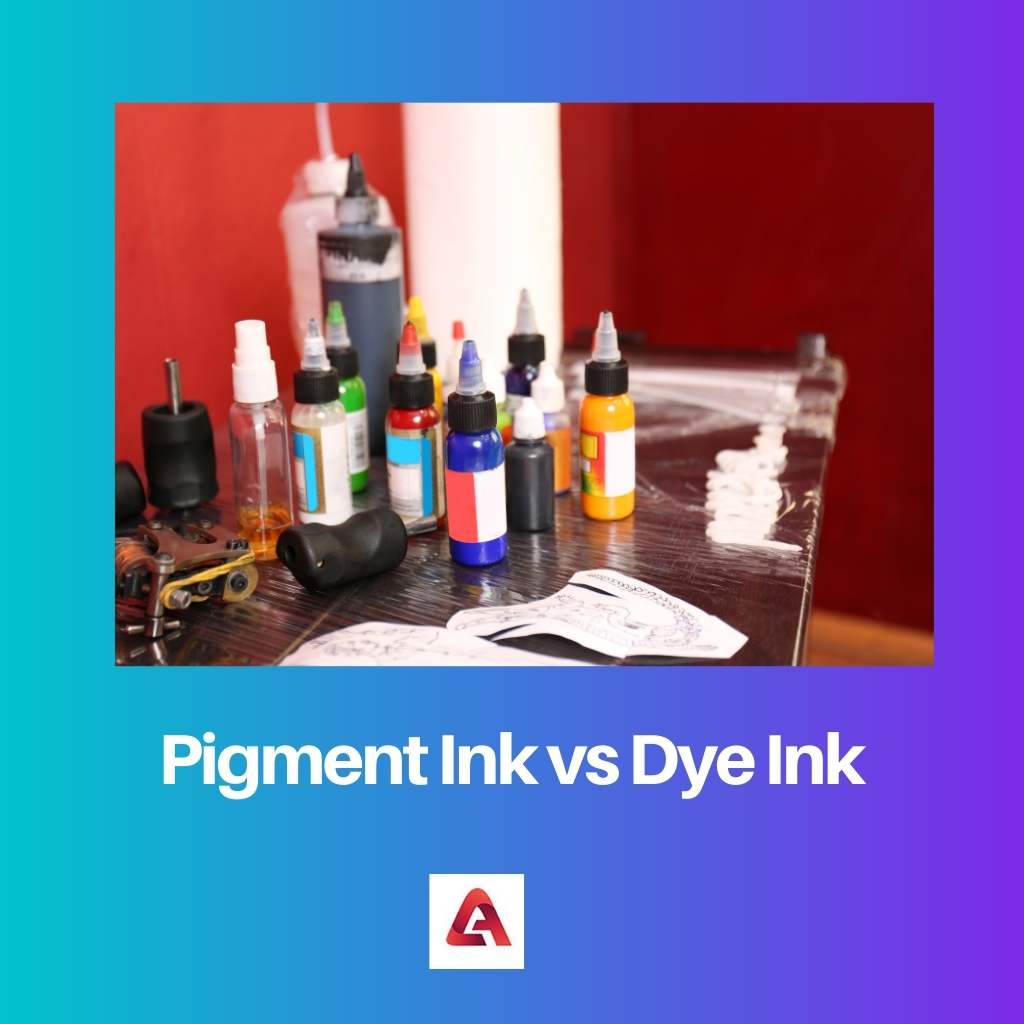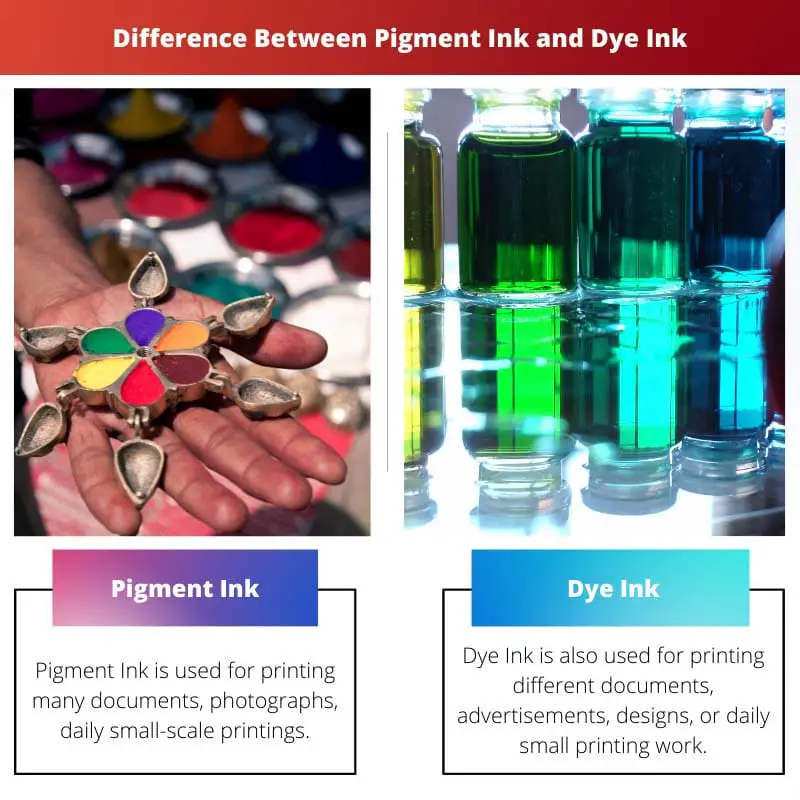In the market, there are multiple types of inkjet printers present that works on the principle of different inks. The different printers use dye inks and pigment inks to print varied documents, pictures, etc.
Both the available inks are water-based and mostly preferred by designers, photographers, in homes, etc. These types of printers are best for small-scale printing work.
Key Takeaways
- Pigment inks offer better longevity and fade resistance than dye inks.
- Dye inks produce more vibrant colors and smoother gradients than pigment inks.
- Pigment inks tend to be more expensive and are more suitable for professional printing purposes.
Pigment Ink vs Dye Ink
The difference between Pigment Ink and Dye Ink is that the paper fibre does not absorb Pigment Ink but forms a thick layer on the surface, while comparatively, on the other hand, Dye Ink gets readily absorbed on the surface of the paper fibre. The composition of the pigment ink is mainly in powdered form, while on the other side, the composition of the dye ink is completely made of liquid.

Pigment Ink is used for printing many documents, photographs, and daily small-scale printings. The inks are manufactured with much greater effort and require a lot of labour, making the printing cost quite expensive as the ink price increases.
The composition of the ink includes the powder form, which is suspended in a liquid.
Dye Ink is also used for printing different documents, advertisements, designs, or daily small printing work.
Manufacturing this ink doesn’t require much work, which made the overall cost of printing with dye ink much cheaper than pigment ink. The composition of the ink includes the overall liquid form of color.
Comparison Table
| Parameters of Comparison | Pigment Ink | Dye Ink |
|---|---|---|
| Composition | In powder form | In liquid form |
| Color Stability | Forms thick layer on the paper | Gets absorbed on the paper |
| Interaction with Water | Resistant | Flow consistency |
| Ink Quality | Low | High |
| Price | Expensive | Cheap |
What is Pigment Ink?
Pigment Inks are the composition of various powdered form colors that is dissolved in a liquid solution forming the actual color to be used as printing ink.
The color powder involves very small, tiny, suspended particles in it. Because of it, the print material’s shelf life or durability gets extended.
Some of the advantages of using pigment ink as their choice may include the longer durability and long life of the material.
Also, the material printed using any pigment dye is considered water-resistant, and if it is exposed to special UV light, the shelf life increases. Even the print color of the material is light.
When the ink color contacts the paper fibre, it forms a thick layer on it and doesn’t get absorbed beneath.
The manufacturing of the ink includes the genuine effort of many labourers, which makes the ink expensive, and on an overall basis, the printing cost of the ink gets high.
What is Dye Ink?
Dye ink includes the composition of the liquid, that is, they are colorants that are already dissolved in a liquid solution. The invention of dye ink is way much older in the market than the new-age printers.
But despite this, the print material’s shelf life or durability is not as good as Pigment ink.
Some of the advantages of using dye ink as their choice include the vibrant and vivid color of the print material. As the ink gets washed off, it may come off if it interacts with water until it is safeguarded on any special coating.
Also, the quality of the ink after printing is immensely good.
On interaction with water, the ink gets washed off, and also, when it interacts with the surface of paper fibre, the ink gets readily absorbed beneath it and, after some time, evaporates, sticking the dye behind.
Main Differences Between Pigment Ink and Dye Ink
- The main constituent forming the pigment ink includes a powder of the color which is then suspended in a liquid and forms the actual product, while comparatively, on the other hand, the main constituent of the dye ink is already in the liquid state.
- The color stability shown by the pigment ink includes that when the color touches the paper fibre, it immediately forms a thick as it doesn’t absorb on the paper completely while comparatively, on the other hand, the color stability shown by the dye ink includes the formation of smooth surface as the ink gets absorbed on the paper fibre.
- The pigment ink shows an advantage in the matter of interaction with water as they are resistant towards the water, while comparatively, on the other hand, the dye ink has the disadvantage of possessing a flowing consistency when interacting with the water.
- The quality of the ink for pigment is low, while comparatively, on the other hand, the quality of the ink for dye is very good.
- The price charged for the pigment ink is quite expensive, while comparatively, on the other hand, the price charged for the dye ink is cheap.


The explanations provided are quite enlightening, but I can’t help but wonder if there are other factors to consider as well.
I agree, the post was a bit confusing in that sense.
I must say, the information provided did leave me wanting more. I’m still not entirely sure about the primary distinctions between them.
The comparison table was really helpful I think. It’s good to have a visual of the side by side differences.
Honestly, it’s hard to say if it’s worth it to pay extra for the pigment inks.
I find it interesting how much work goes into the production of pigment inks and how that affects the price.
Yes, I agree. The article should have gone into more detail regarding the environmental impact of each type of ink.
I like that it goes into the technical aspects, sometimes this info is hard to come by unless you’re working directly with these products.
I think the information was quite clear, but this subject does require some technical understanding.
It is always interesting to study the differences between these types of ink. I particularly found the pigment ink to do an outstanding job.